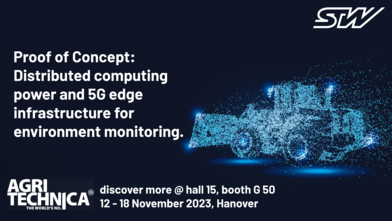Edge computing with 5G, and storage and computing power in base stations, enable effective environment monitoring in mobile work processes. The combination utilizes the advantages of data pre-processing on the machine, additional data sources from stationary infrastructure and AI to build an overall picture in real time. STW developed a concept study, in collaboration with Amazon Web Services (AWS) and Vodafone, demonstrating the benefits of such distributed computing architectures.
Cloud computing has long since arrived in the agricultural and construction industries. Large machine manufacturers use providers such as Amazon Web Services to outsource big data processing and improve production processes. These providers offer the advantage of being able to collect gigabytes of data continuously from countless sources, and quickly scale their services.
STW has demonstrated in a Proof of Concept (PoC) how the interaction of powerful computer architectures on mobile machines and stationary surveillance cameras, with the help of a 5G edge computing infrastructure, realizes assistance functions in a construction site scenario. AWS Wavelength embeds AWS computing and storage services into Vodafone 5G networks, providing an edge computing infrastructure for application development and scaling. In this case, edge computing refers to the computing power and storage capacity not being in a data center, but rather locally in the respective base station. This enables extremely low latencies in the transmission and processing of data.
STW used high-performance computers on the machines to pre-process video data. Additional data from the surrounding infrastructure, for example from surveillance cameras on light poles, were taken into account. Data from both the machines and the surveillance cameras were sent to the next base station over 5G. Two advantages of 5G come into play here: high data rates and low latency or real-time capability. In the edge computing infrastructure, AI was used to evaluate the video data and transmit the results back to the mobile participants in real time. Thus, with the help of AWS services, camera-based environment monitoring was realized for an excavator.
This PoC demonstrates how the complexity of the data streams in the construction site ecosystem can be managed. A vast amount of heterogeneous data from mixed machine fleets can be combined with the information from intelligent infrastructure and channeled, by means of cloud computing, for decision-making in automated or autonomous processes.
Corresponding use cases can be derived for agricultural technology, for example as an alternative to spatially limited wireless infield communication. Looking to the future, here too, heterogeneous fleets of machines must be networked, up to and including field swarms. With the architecture presented in the PoC, vehicles and machines could be seamlessly networked across regions, for example to optimize field logistics. Machine manufacturers could also use this networking architecture as a basis for machine learning concepts. You can find out more about these ideas and our solutions at our stand at Agritechnica from 12-18 November in Hanover.
